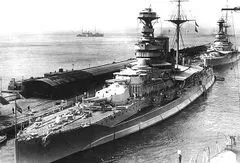
Beginnings of the Queen Elizabeth-class battleships
Beginning of the Queen Elizabeth class battleships. The main artillery salvo of Vallianta. The muffled sections of the casemates show how low the stern 152-mm cannons should have been above the water surface. Photo Tsushima.su
The heroes of the text below are some of the most famous ships of the Great War. Everything seems to be known about them. However, the history of their creation is shrouded in mystery. Most of the rejected pre-project documents were probably destroyed. The file containing ship coating records for these battleships begins with the approval of the design, while for other types of ships it dates back to a much earlier period. As a result, the history of their creation, concept changes and rejected variants were described only on the basis of later memoirs or letters. How accurate they are, one can only guess.
genesis
At the end of the XNUMXth century, the Royal Navy was the most powerful navy in the world. The British had more battleships at their disposal than two successive fleets combined, and more than twice as many large cruisers. The fleets of France were then taken as a standard
and Russia. The position of the British then was good, that apart from these two potential opponents, no one else should have worried, or to some extent the slowly growing Japanese fleet, which was built mainly in ... British shipyards, with Japanese money. The rest of the world hardly mattered. To make Albion even easier, in Russia, and especially in France, it took a long time to build heavy ships. It so happened that when the French ship entered service, the British already had an answer for her modernized successor.
At the beginning of the XNUMXth century, the situation began to change. Although the British defense and shipbuilding industry was still the strongest in the world and continued to develop, new players began to join the group of countries capable of creating a strong navy. It became increasingly difficult to maintain the position of hegemon, especially since the British rulers were increasingly interested in the social problems of citizens that influenced the election results. Simply put, the world did not have enough money for all the whims. Of course, it is worth remembering the context of “no money”. So far we are talking about a fleet that builds for its needs as much as the rest of the world put together, and a significant part of this “rest of the world” is being built on or with a significant share of British factories, albeit with the customer’s money.
It was Fischer
In 1904, the “Fischer era” began. Admiral John Fisher, the first sea lord of the Admiralty, was an extraordinary and highly controversial figure. He undoubtedly possessed great organizational talent and knew how to ruthlessly achieve his goal. If necessary, he could lie, lie to himself, contradict himself in one meeting, depending on who he was talking to, just to get what he wanted. Assuming "rule", he vigorously set about reforming the Royal Navy, seeking to increase the efficiency of the fleet while reducing the cost of building and maintaining it. The introduced reforms were multi-layered and deserve a separate study. One of the elements was the creation of a series of the largest and most powerful battleships in the world. By the way, the most expensive in the Royal Navy.
The higher unit cost only at first glance contradicted the financial cuts. Battleships were to be proportionately much more valuable than expensive. In short, quality had to rise faster than cost, so far fewer ships were needed to complete the task. Despite the higher unit cost, everything had to be cheaper.
In accordance with these assumptions, HMS Dreadnought was created. Fisher was inextricably linked to his contracting and construction. Whether he wanted to create this battleship or “didn’t want to, but had to” doesn’t really matter. Undoubtedly, without him, the ship would not have been built at that time, would not have been built so quickly and would not have been so revolutionary.
In parallel with the new supermatchship, plans for a super cruiser were being developed, resulting in the creation of three Invincible ships.
